It takes about 20 minutes for a person to process a single submission for a loan application. Multiply that across dozens or hundreds of files, and the hours pile up fast. That is time lost on work that doesn’t grow the business.
This is where document automation software makes a difference. These tools handle tasks such as client intake and data scrubbing with speed and accuracy.
In this article, we will look at seven document automation platforms available today and how they help organizations improve efficiency and stay competitive.
What is a Document Automation Platform?
A document automation platform is software that helps businesses manage documents faster and with fewer mistakes.
Instead of typing the same information again and again, the system uses document templates and pulls the same data from tools like CRM or ERP systems. This makes automated document creation simple, even for complex documents.
With document generation, companies can create accurate documents without manual reentry. Automated document workflows replace slow, repetitive tasks with digital steps that save time and improve accuracy.
For example, funders can collect and track borrower files through secure portals, making document processing quicker and more transparent.
The platform also supports regulatory compliance by keeping records organized and consistent. Since the same data flows across different documents, businesses avoid errors and improve trust with clients.
7 Best Document Automation Software Available
Smartsheet reports that over 40% of workers spend a quarter of their week, nearly 10 hours, on repetitive tasks like data entry and document prep.
Here are seven document automation software options that can help you win back those hours.
1. Heron
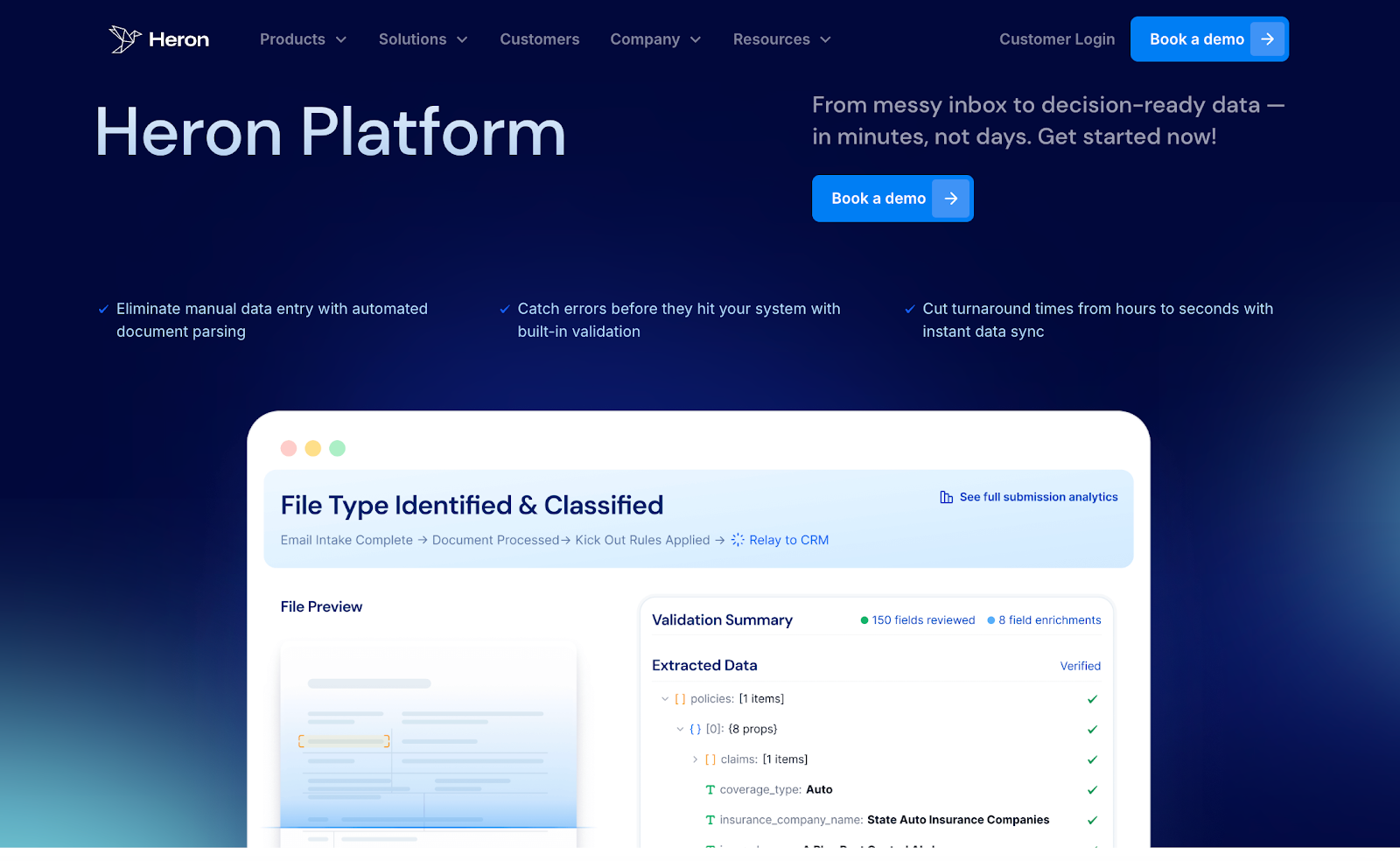
Heron helps SMB and MCA funders manage complex workflows by turning messy documents into decision-ready data in minutes.
Teams no longer spend hours on document review or manual data entry. With automated parsing, built-in checks, and instant updates, the process is faster, more accurate, and easier to handle.
The platform manages the full document lifecycle, from intake to delivery, so funders can work faster without worrying about missing or incorrect data.
Key Features
- Automated intake - Collects and classifies documents from email, portals, or APIs without manual sorting
- Smart parsers - Scrubs and structures data from complex forms, even messy or handwritten ones, while detecting duplicates and missing fields
- Data enrichment - Normalizes and augments information with third-party and internal sources, such as vehicle data or financial metadata
- Validation checks - Applies business rules to catch errors, flag non-compliant entries, and reduce rework during document review
- Analytics insights - Surfaces financial and operational metrics like premiums, loss ratios, and utilization rates for faster decision-making in complex workflows
- Instant relay - Sends clean data directly into your CRM, policy admin system, or database without manual uploads
- Secure framework - SOC2, GDPR, and CCA compliant, trusted by over 130 financial and professional services firms
2. Docupilot
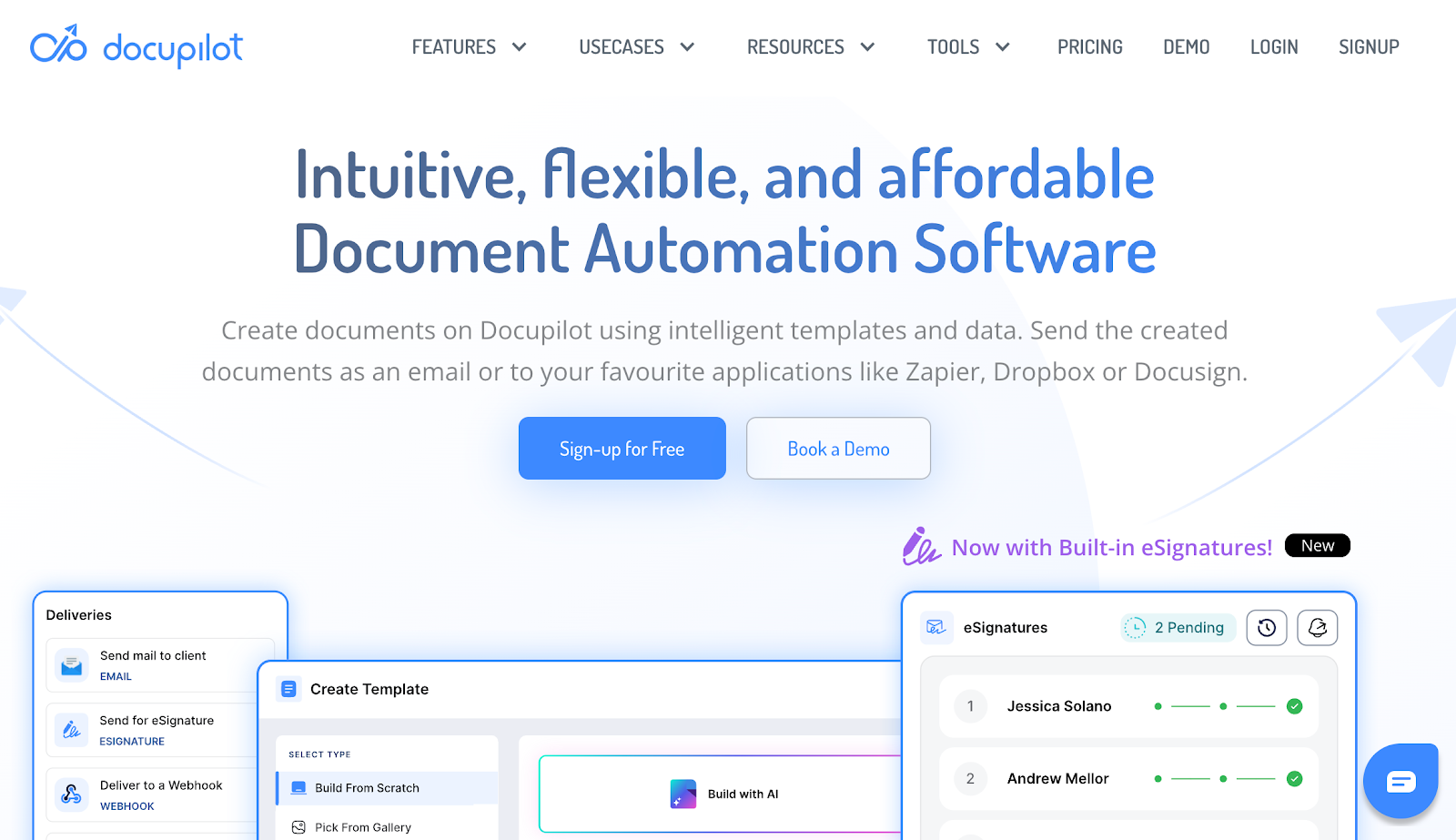
Docupilot is a document automation platform that helps funders and insurance brokers generate accurate business documents with just a few clicks.
Teams can use custom templates and data mapping to cut down on repetitive tasks and keep documents like proposals, agreements, contracts, and reports consistent.
The platform connects with common tools, supports secure document review, and works with complex workflows without needing any coding skills.
Key Features
- Custom templates - Build reusable templates that adapt to client details, making document creation consistent and efficient
- Dynamic data mapping - Pulls data from CRMs, HR systems, or databases to populate documents automatically
- Conditional logic - Applies rules to personalize documents based on specific inputs or client requirements
- Built-in eSignatures - Allows recipients to review and sign documents within the platform without extra tools
- Multi-format export - Generates documents in formats such as PDF, DOCX, or HTML for easy sharing and storage
3. Quadient Inspire
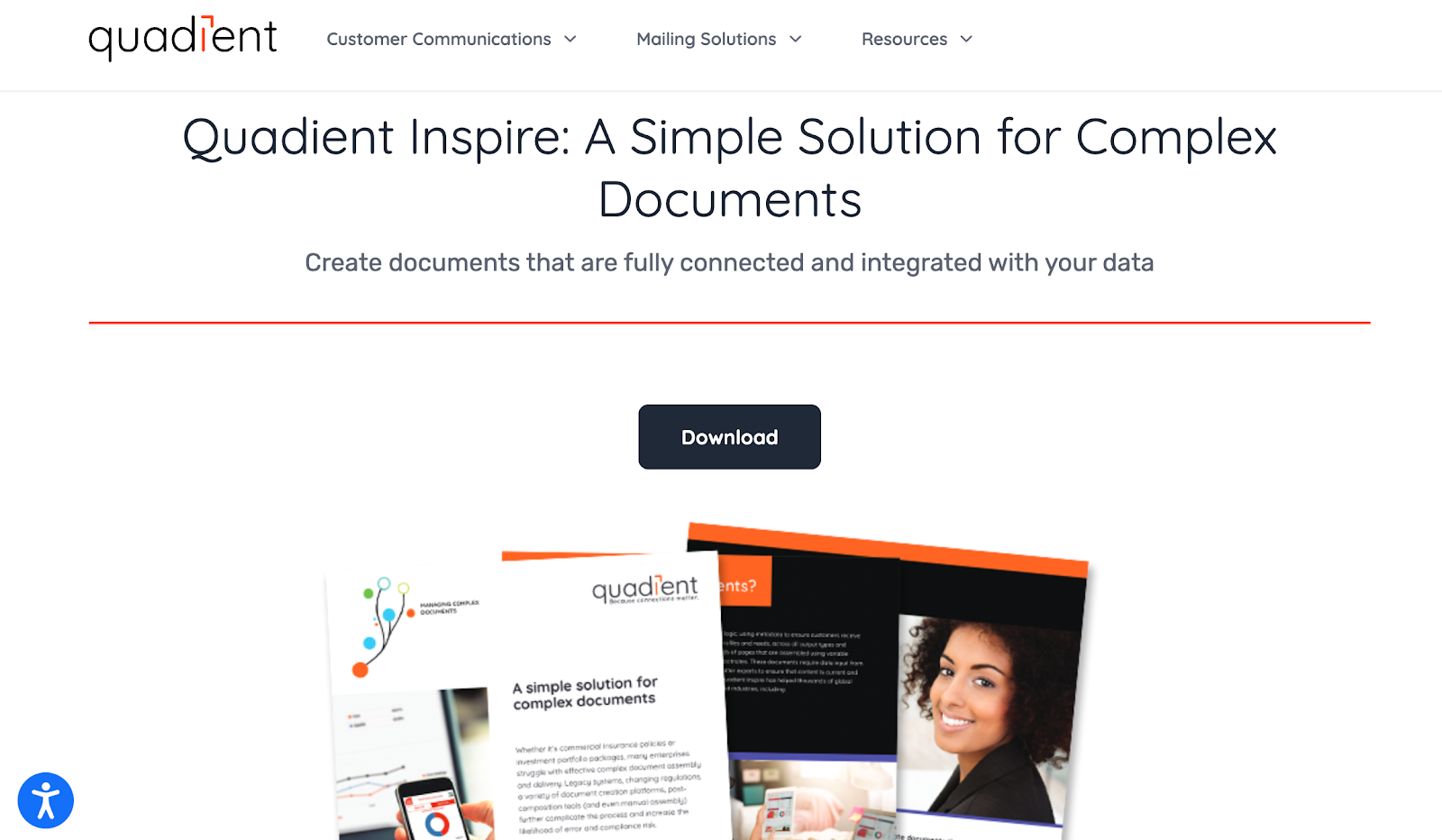
Quadient Inspire is a customer communications management platform built to handle complex documents across many industries.
For funders and insurance brokers, it helps create connected, compliant, and personalized documents like policies, contracts, agreements, and portfolio reports.
The platform also manages complex workflows by bringing together automation, collaboration, and data handling, which reduces manual work and lowers compliance risks.
Key Features
- Connected document creation - Builds documents that are fully integrated with enterprise data sources
- Reusable components - Use predefined templates and content blocks to maintain consistency and save time
- Collaboration tools - Provide a shared workspace for business users to review and approve documents
- Automation functions - Supports automated amendments, renewals, and approval processes for faster delivery
- Omnichannel communication - Delivers documents across multiple channels with bi-directional communication capabilities
4. Nanonets
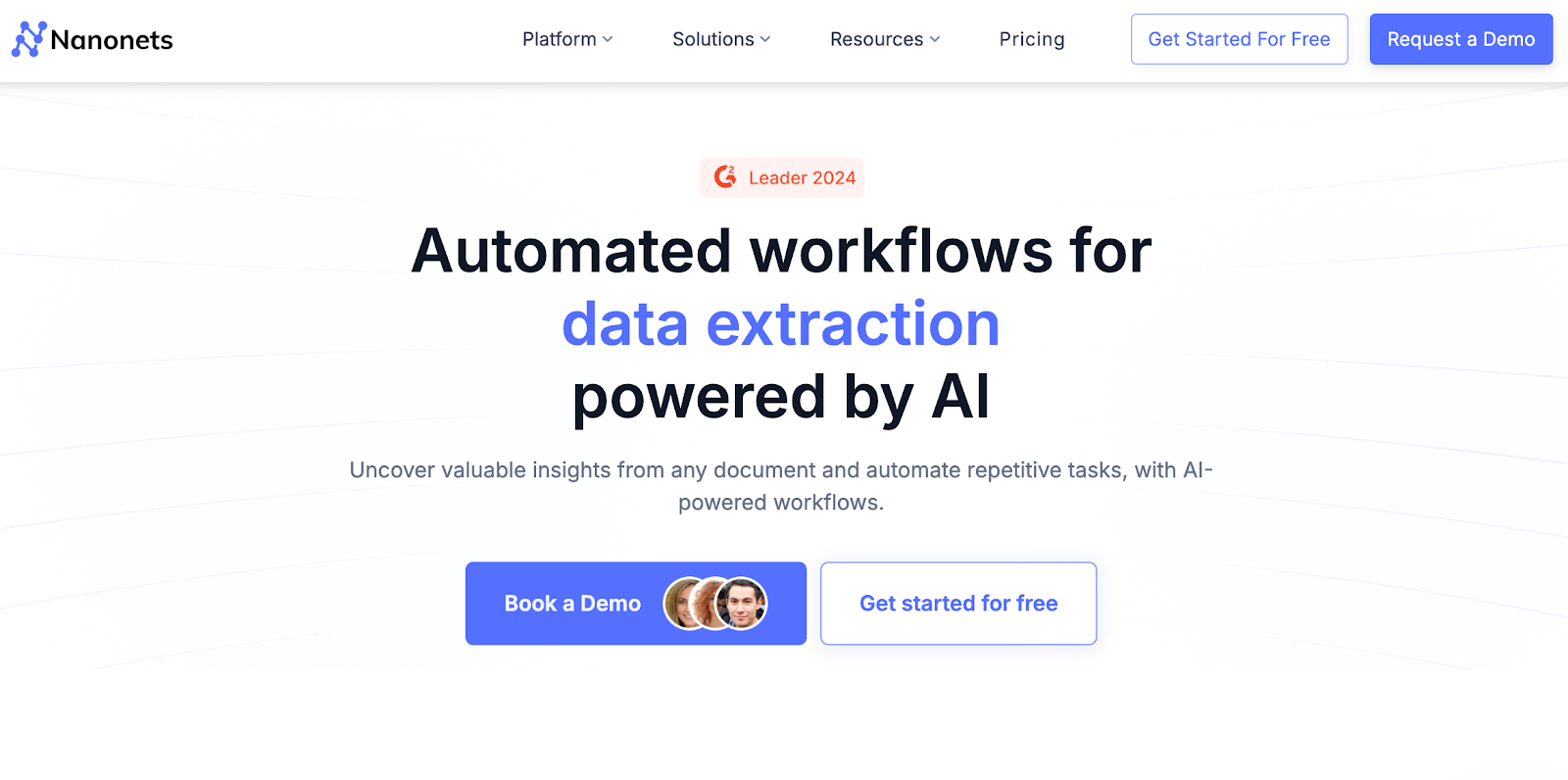
Nanonets is an AI-powered document automation platform that supports automated workflows for processes such as invoice processing, claim handling, reconciliation, and document approvals.
This tool helps insurance brokers easily extract information from financial and insurance forms, speed up document review, and connect structured data directly to existing systems.
The platform is designed to handle unstructured data from multiple sources and convert it into actionable information.
Key Features
- AI-powered data extraction - Captures and structures information from documents, emails, and databases without predefined templates
- Automated workflows - Supports invoice processing, accounts payable, claim processing, and reconciliation tasks with AI-driven workflows
- Decision engines - Flags and validates data, applies business rules, and manages exceptions for review within familiar tools like email or Slack
- System integrations - Connects to CRMs, ERPs, and cloud storage services to move structured data across business systems
- Multi-format export - Outputs scrubbed and processed data into formats such as XLS, CSV, or XML for downstream use
5. Docsumo
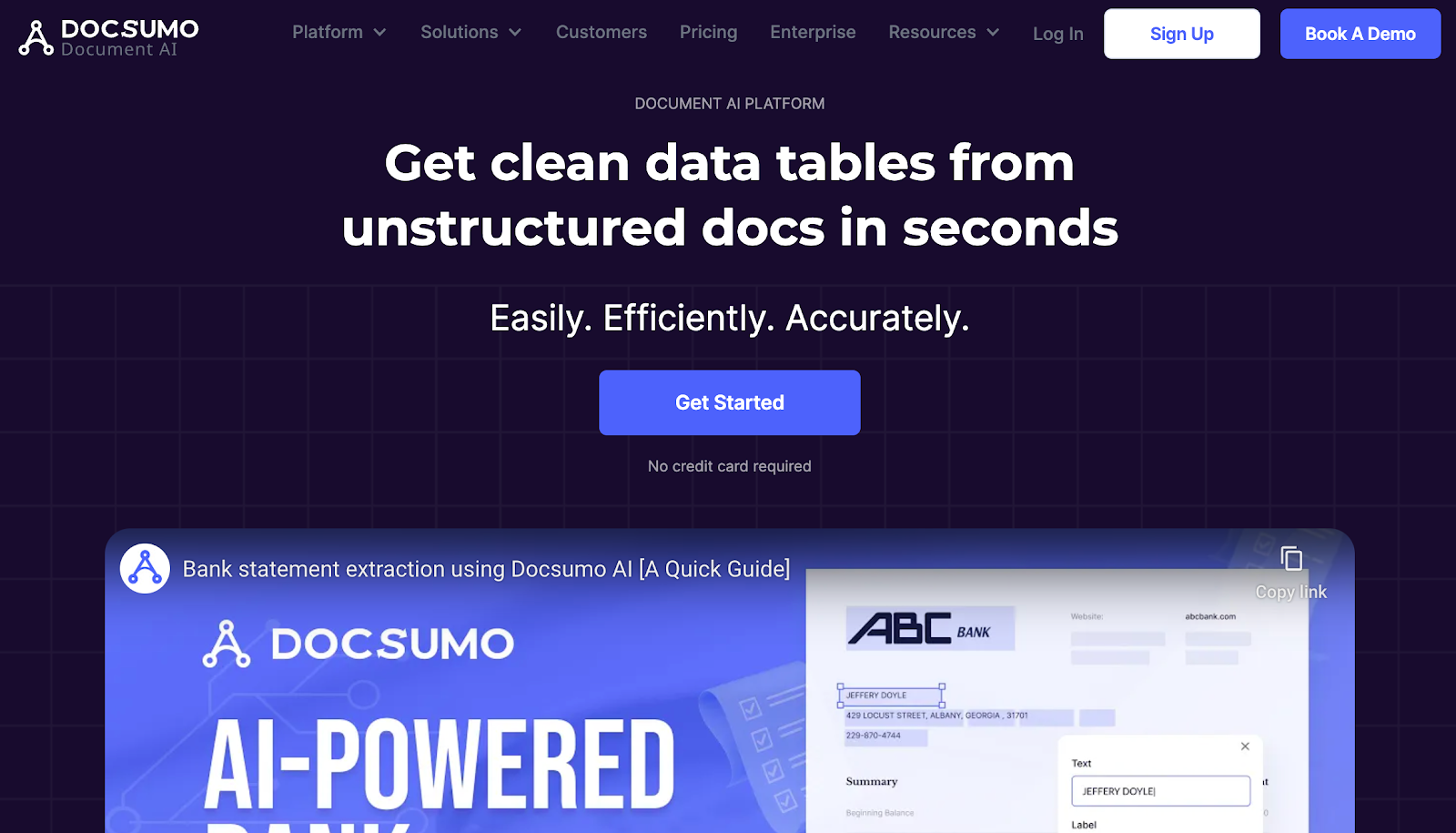
Docsumo is a document AI platform that scrubs structured data from unstructured files in seconds.
The platform can help brokers process forms such as invoices, utility bills, contracts, ACORD forms, and financial statements with a high level of accuracy.
The platform reduces the need for manual document review by validating scrubbed data against business rules and integrating results directly with downstream systems.
Key Features
- Multi-format ingestion - Accepts documents in formats such as PDF, PNG, JPG, Excel, TIFF, and TXT through email, API, or cloud storage
- AI-powered scrubbing - Captures key values and tables from complex unstructured documents, including contracts, statements, and insurance forms
- Data validation - Applies custom rules and checks within and across documents to reduce errors and improve reliability
- System integration - Connects scrubbed data directly to CRMs, underwriting systems, and financial platforms through ready-to-use APIs
- Data security - Provides GDPR, SOC2, and HIPAA compliance with end-to-end encryption and multi-region data storage options
6. DocuClipper
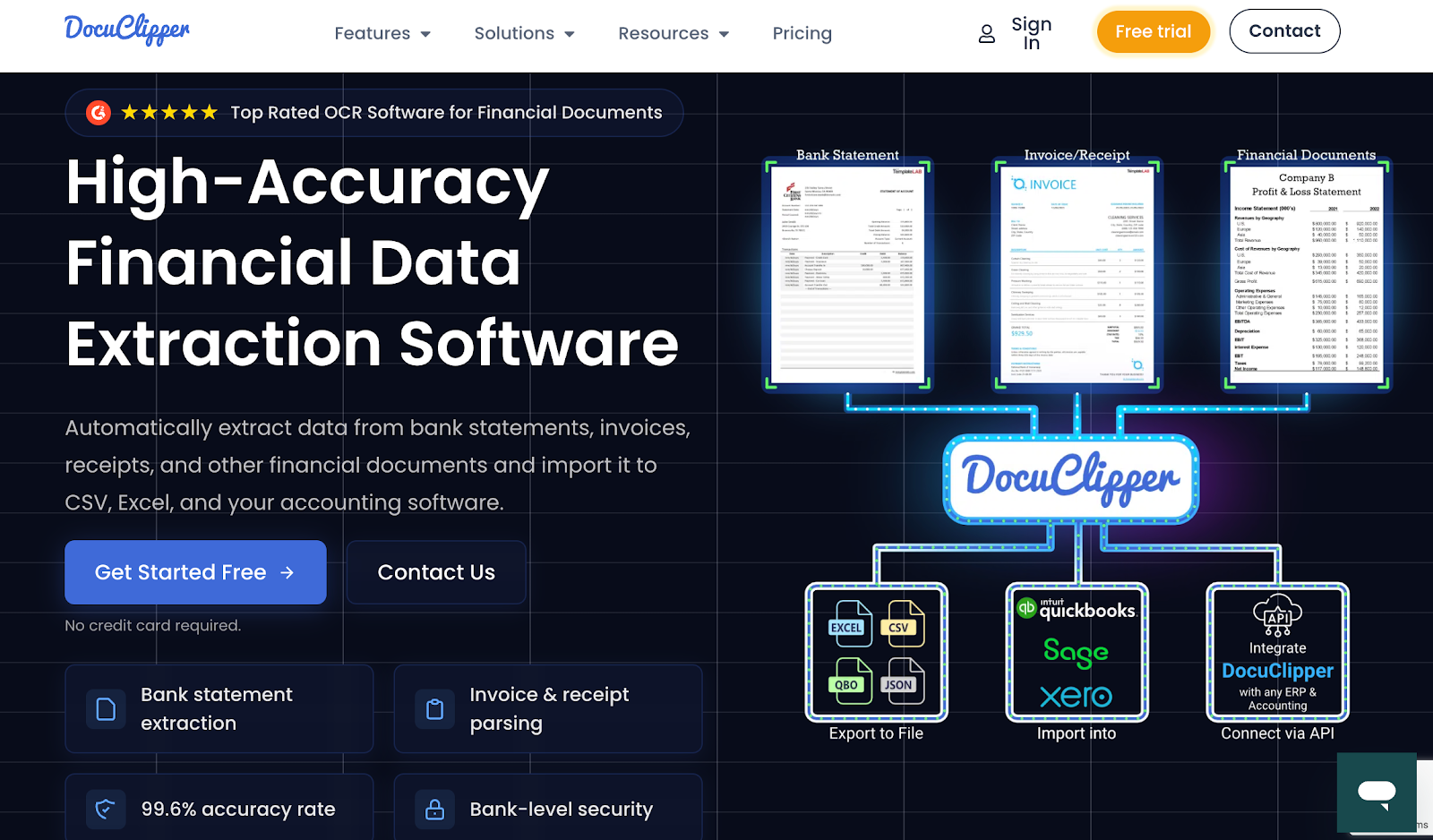
DocuClipper is a financial data extraction platform that converts information from documents such as bank statements, invoices, receipts, and tax forms into structured formats like CSV or Excel.
The software can support faster document review, improve accuracy in financial checks, and integrate clean data directly into accounting, ERP, or CRM systems.
It also helps reduce manual entry when handling sensitive client information, ensuring consistency and security throughout the process.
Key Features
- Bank statement scrubbing - Converts scanned or digital bank statements into structured data for review and reconciliation
- Invoice and receipt parsing - Extracts unlimited line items from invoices and receipts for faster processing
- Custom templates - Creates reusable templates to standardize data capture across financial documents and client information
- System integrations - Exports data directly into accounting software, ERPs, or CRMs in the required format
- Data security - Provides SOC 2 compliance and AES 256-bit encryption to protect sensitive financial and client information
7. Rossum
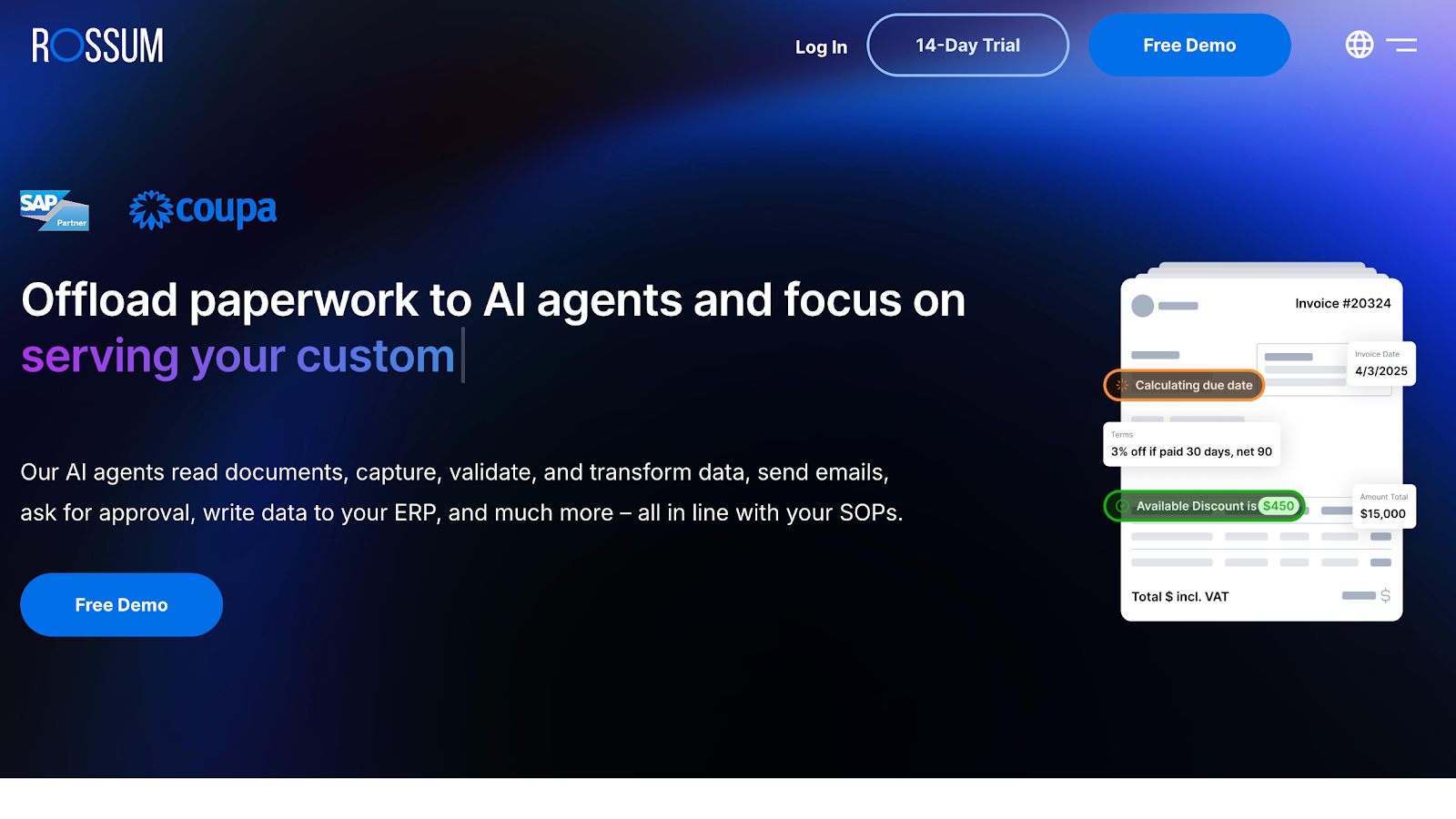
Rossum is an AI-driven document processing platform that automates the handling of transactional documents.
It can reduce the time spent on paperwork by capturing, validating, and transforming client information directly in line with existing SOPs.
The platform supports document approvals, integrates with ERP systems, and combines AI with human collaboration to handle complex workflows and regulatory requirements.
Key Features
- Document ingestion - Receives documents from email, scanners, shared drives, and other channels for processing
- AI-powered extraction - Uses proprietary large language models trained on millions of transactional documents to capture data, including handwriting and multiple languages
- Validation and augmentation - Applies business rules and user feedback to validate data and improve accuracy during document review
- End-to-end automation - Automates workflows such as sending emails, requesting approvals, and writing data to ERP systems
- System integration - Connects processed data seamlessly into ERP and other downstream systems without additional manual work
Benefits of Automated Document Workflows
Automated document workflows bring numerous benefits to MCA brokers and funders. Let’s discuss the most important ones.
Faster Processing
Speed matters in MCA funding, where access to capital often needs to be immediate. Automated workflows process financial statements, PDF documents, and identification files in minutes rather than hours.
For example, scrubbing client data from bank statements no longer requires staff to manually enter numbers line by line.
This faster turnaround time allows businesses to provide funding quickly, giving them a clear advantage in a competitive market.
Greater Accuracy
Manual processes often lead to human errors, which can delay decisions or cause compliance issues.
With automated document drafting and AI-powered processing, data is pulled directly from verified sources. This eliminates duplicate data entry and improves consistency.
For instance, once client data is entered into the system, it automatically populates across all necessary business documents, reducing the chance of mismatched information.
Higher Efficiency
Automation takes over repetitive tasks such as document intake, classification, and verification.
Staff can then focus on reviewing business context, analyzing risks, and strengthening client relationships.
This shift from administrative work to higher-value activities boosts overall productivity and creates smoother workflows across teams.
Better Client Experience
Borrowers want the process to be simple and clear. Automated workflows make this possible by giving real-time updates, digital submission portals, and faster approvals.
A small business owner applying for funding can upload documents through a secure system and track progress without waiting for repeated emails or calls.
Easy Scalability
As application volumes grow, automation makes it possible to process more files without needing to hire additional staff.
Whether managing 50 or 500 applications, the system can adjust to the demand. This scalability allows businesses to grow while keeping costs and workloads under control.
Lower Costs
Automated processes reduce the need for manual data entry, cutting down on staffing expenses and overhead.
For example, instead of hiring additional employees to review hundreds of applications, businesses can rely on automated tools to handle most of the workload.
Be Free of Document-Heavy Tasks with Heron
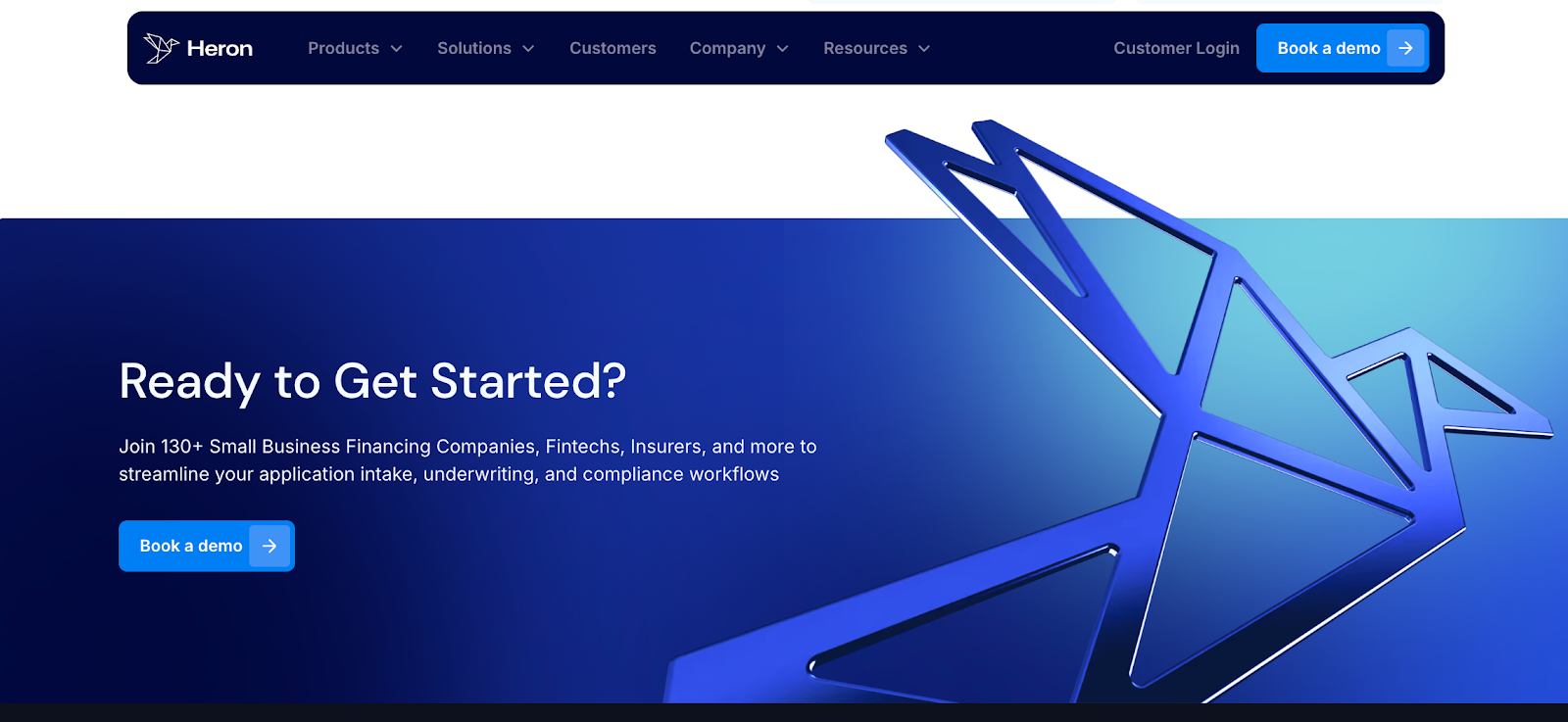
Teams often spend valuable hours on client intake, sorting forms, and rekeying new documents into their systems. Heron is designed to free your team from paperwork so they can focus on funding deals.
It takes over repetitive steps by standardizing files, scrubbing data, and pushing it directly into your CRM. This approach saves time spent on manual prep and reduces errors that slow down deal flow.
Automation also streamlines how information moves through your process. With immediate access to structured records, underwriters can concentrate on risk and decision-making rather than administrative tasks.
The result is higher efficiency, better accuracy, and faster responses. Heron helps you process more deals with the same team, making your workflow sharper and more scalable without adding headcount.
FAQs About Document Automation Platform
What is the best document automation software?
The best document automation software depends on your needs. Some platforms focus on law firms and legal documents, while others serve IT teams, human resources, or even a law practice.
For funders and insurance brokers, Heron stands out thanks to features like automatic document intake (via emails, bulk upload, or APIs), smart classification, scrubbing, and many more.
What is document automation software?
Document automation software helps create, edit, and manage files faster by cutting out manual work.
It’s often used in law firms to draft contracts, in HR to prepare onboarding files, in IT teams to handle reports, and by funders and insurance brokers to prepare financial agreements or policy documents.
How do you automate documentation?
You automate documentation by setting up dynamic templates that fill in client details or employee data automatically.
For example, a law practice can generate legal documents, human resources can prepare letters, and insurance brokers or funders can automate document intake with just a few clicks. This process cuts down repetitive tasks and reduces mistakes.
What is the best automation platform?
The best automation platform fits your actual workflows and industry needs. For example, Heron is built for high-volume document workflows in industries like lending, insurance, and finance.
It handles end-to-end work: intake, classification, data scrubbing, enrichment, validation, and syncing structured data into CRMs or systems of record. It doesn’t force you to rebuild your stack, and it flags edge cases so humans can step in when needed.


